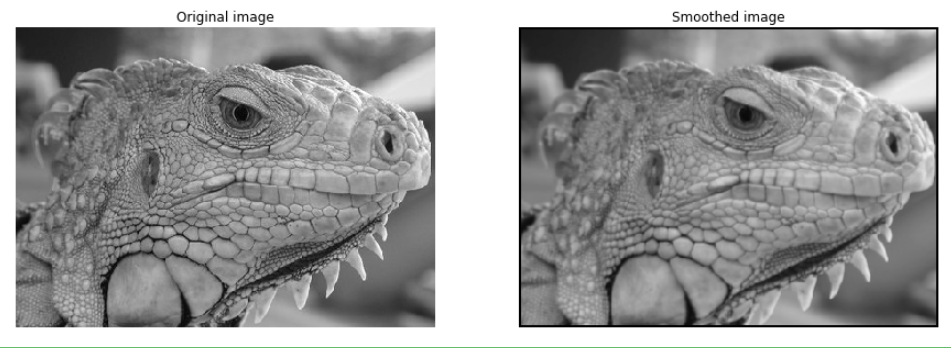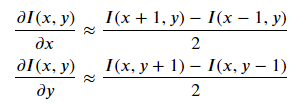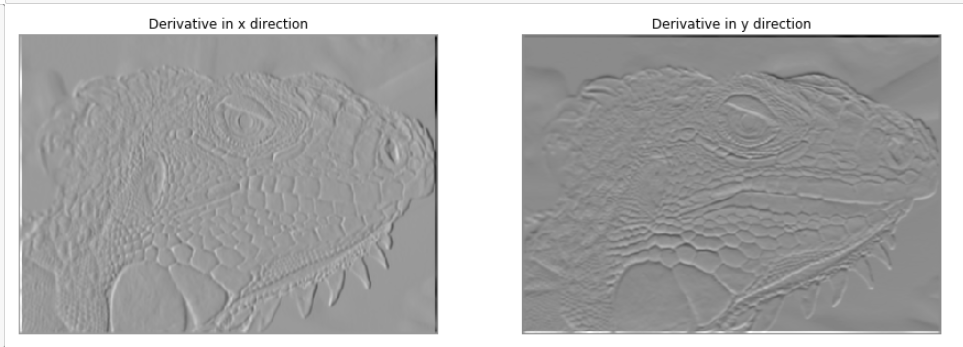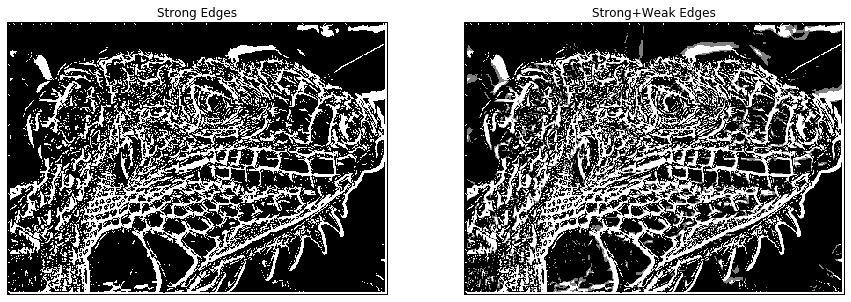前言
Canny边缘检测是一种非常流行的边缘检测算法,是John Canny在1986年提出的。它是一个多阶段的算法,即由多个步骤构成。本文主要讲解了Canny算子的原理及实现过程。
一、Canny的实现步骤
通常情况下边缘检测的目的是在保留原有图像属性的情况下,显著减少图像的数据规模。有多种算法可以进行边缘检测,虽然Canny算法年代久远,但可以说它是边缘检测的一种标准算法,而且仍在研究中广泛使用。
- 应用高斯滤波来平滑图像,目的是去除噪声
- 找寻图像的强度梯度(intensity gradients)
- 应用非最大抑制(non-maximum suppression)技术来消除边误检(本来不是但检测出来是)
- 应用双阈值的方法来决定可能的(潜在的)边界
- 利用滞后技术来跟踪边界
二、具体实现
1.高斯平滑滤波
滤波是为了去除噪声,选用高斯滤波也是因为在众多噪声滤波器中,高斯表现最好(表现怎么定义的?最好好到什么程度?),你也可以试试其他滤波器如均值滤波、中值滤波等等。一个大小为(2k+1)x(2k+1)的高斯滤波器核(核一般都是奇数尺寸的)的生成方程式由下式给出:
下面是手动创建一个高斯滤波核的函数:
def gaussian_kernel(size, sigma):
""" Implementation of Gaussian Kernel. This function follows the gaussian kernel formula, and creates a kernel matrix. Hints: - Use np.pi and np.exp to compute pi and exp. Args: size: int of the size of output matrix. sigma: float of sigma to calculate kernel. Returns: kernel: numpy array of shape (size, size). """
kernel = np.zeros((size, size))
### YOUR CODE HERE
for x in range(size):
for y in range(size):
kernel[x, y] = 1 / (2*np.pi*sigma*sigma) * np.exp(-(x*x+y*y)/(2*sigma*sigma))
### END YOUR CODE
return kernel
这是定义卷积计算过程的函数:
def conv(image, kernel):
""" An implementation of convolution filter. This function uses element-wise multiplication and np.sum() to efficiently compute weighted sum of neighborhood at each pixel. Args: image: numpy array of shape (Hi, Wi). kernel: numpy array of shape (Hk, Wk). Returns: out: numpy array of shape (Hi, Wi). """
Hi, Wi = image.shape
Hk, Wk = kernel.shape
out = np.zeros((Hi, Wi))
# For this assignment, we will use edge values to pad the images.
# Zero padding will make derivatives at the image boundary very big,
# whereas we want to ignore the edges at the boundary.
pad_width0 = Hk // 2
pad_width1 = Wk // 2
pad_width = ((pad_width0,pad_width0),(pad_width1,pad_width1))
padded = np.pad(image, pad_width, mode='edge')
### YOUR CODE HERE
x = Hk // 2
y = Wk // 2
# 横向遍历卷积后的图像
for i in range(pad_width0, Hi-pad_width0):
# 纵向遍历卷积后的图像
for j in range(pad_width1, Wi-pad_width1):
split_img = image[i-pad_width0:i+pad_width0+1, j-pad_width1:j+pad_width1+1]
# 对应元素相乘
out[i, j] = np.sum(np.multiply(split_img, kernel))
# out = (out-out.min()) * (1/(out.max()-out.min()) * 255).astype('uint8')
### END YOUR CODE
return out
接下来就是用自己写的高斯滤波卷积核去卷原来的图片:
# Test with different kernel_size and sigma
kernel_size = 5
sigma = 1.4
# Load image
img = io.imread('iguana.png', as_gray=True)
# Define 5x5 Gaussian kernel with std = sigma
kernel = gaussian_kernel(kernel_size, sigma)
# Convolve image with kernel to achieve smoothed effect
smoothed = conv(img, kernel)
plt.subplot(1,2,1)
plt.imshow(img)
plt.title('Original image')
plt.axis('off')
plt.subplot(1,2,2)
plt.imshow(smoothed)
plt.title('Smoothed image')
plt.axis('off')
plt.show()
结果是下面两张图片,可以看到图像的边缘被明显地模糊了,图像的抗噪能力变强了。
总结一下这一步:高斯滤波其实就是将所指像素用周围的像素的某种均值代替(即卷积核),卷积核尺寸越大,去噪能力越强,因此噪声越少,但图片越模糊,canny检测算法抗噪声能力越强,但模糊的副作用也会导致定位精度不高。
高斯的卷积核大小推荐:一般情况下,尺寸5 * 5,3 * 3也行。
2.计算梯度大小和方向
对于一张图片来说,梯度能很好地反映其像素的变化情况,而梯度变化越大,说明相邻像素之间存在着较大差异,放大到整张图片来说,就是在某一块区域存在边缘,从视觉上来说就是用黑到白(灰度图片读入)。
梯度的计算分为大小和方向,首先需要求出各个方向上的梯度,然后求平方根和切线。
以下是x、y方向上梯度的计算方式:
代码实现:
def partial_x(img):
""" Computes partial x-derivative of input img. Hints: - You may use the conv function in defined in this file. Args: img: numpy array of shape (H, W). Returns: out: x-derivative image. """
out = None
### YOUR CODE HERE
# 对x求偏导
kernel = np.array(([-1, 0, 1], [-1, 0, 1], [-1, 0, 1]))# np.random.randint(10, size=(3, 3))
out = conv(img, kernel) / 2
### END YOUR CODE
return out
def partial_y(img):
""" Computes partial y-derivative of input img. Hints: - You may use the conv function in defined in this file. Args: img: numpy array of shape (H, W). Returns: out: y-derivative image. """
out = None
### YOUR CODE HERE
# 对y求偏导
kernel = np.array(([1, 1, 1], [0, 0, 0], [-1, -1, -1]))# np.random.randint(10, size=(3, 3))
out = conv(img, kernel) / 2
### END YOUR CODE
return out
def gradient(img):
""" Returns gradient magnitude and direction of input img. Args: img: Grayscale image. Numpy array of shape (H, W). Returns: G: Magnitude of gradient at each pixel in img. Numpy array of shape (H, W). theta: Direction(in degrees, 0 <= theta < 360) of gradient at each pixel in img. Numpy array of shape (H, W). Hints: - Use np.sqrt and np.arctan2 to calculate square root and arctan """
G = np.zeros(img.shape)
theta = np.zeros(img.shape)
### YOUR CODE HERE
Gx = partial_x(img)
Gy = partial_y(img)
# 求梯度的大小(平方和的根号)
G = np.sqrt(np.power(Gx, 2) + np.power(Gy, 2))
theta = np.arctan2(Gy, Gx) * 180 / np.pi # 转换成角度制
### END YOUR CODE
return G, theta
可以拿一张图片来测试一下:
# Compute partial derivatives of smoothed image
Gx = partial_x(smoothed)
Gy = partial_y(smoothed)
plt.subplot(1,2,1)
plt.imshow(Gx)
plt.title('Derivative in x direction')
plt.axis('off')
plt.subplot(1,2,2)
plt.imshow(Gy)
plt.title('Derivative in y direction')
plt.axis('off')
plt.show()
可以看到,[-1, 0, 1], [-1, 0, 1], [-1, 0, 1]对应了x方向上的边缘检测(在碰到x方向垂直的边界的时候计算出来的数值更大,所以像素更亮),[1, 1, 1], [0, 0, 0], [-1, -1, -1]同理对应了y方向上的边缘检测。
另外有45°和135°的边缘检测,我这里没有着手去实现,如果有兴趣可以去尝试一下,就是会出现不同方向上的边缘。
3.非极大抑制
用sobel算子或者是其他简单的边缘检测方法,计算出来的边缘太粗了,就是说原本的一条边用几条几乎重叠的边所代替了,导致视觉上看起来边界很粗。非极大抑制是一种瘦边经典算法。它抑制那些梯度不够大的像素点,只保留最大的梯度,从而达到瘦边的目的。
a) 将其梯度方向近似为以下值中的一个[0,45,90,135,180,225,270,315](即上下左右和45度方向)这一步是为了方便使用梯度;
b) 比较该像素点,和其梯度方向正负方向的像素点的梯度强度,这里比较的范围一般为像素点的八邻域;
c) 如果该像素点梯度强度最大则保留,否则抑制(删除,即置为0);
可以看到经过非极大抑制后,图像的边缘明显变细了,边界显得更加清晰了。
代码附上:
def non_maximum_suppression(G, theta):
""" Performs non-maximum suppression. This function performs non-maximum suppression along the direction of gradient (theta) on the gradient magnitude image (G). Args: G: gradient magnitude image with shape of (H, W). theta: direction of gradients with shape of (H, W). Returns: out: non-maxima suppressed image. """
H, W = G.shape
out = np.zeros((H, W))
# 将角度近似到45°的对角线, 正负无所谓, 只看对角线跟水平垂直
# Round the gradient direction to the nearest 45 degrees
theta = np.floor((theta + 22.5) / 45) * 45
### BEGIN YOUR CODE
anchor = np.stack(np.where(G!=0)).T # 获取非零梯度的位置
for x, y in anchor:
center_point = G[x, y]
current_theta = theta[x, y]
dTmp1 = 0
dTmp2 = 0
W = 0
if current_theta >= 0 and current_theta < 45:
g1, g2, g3, g4 = G[x + 1, y - 1], G[x + 1, y], G[x - 1, y + 1], G[x - 1, y]
W = abs(np.tan(current_theta*np.pi/180)) # tan0-45范围为0-1
dTmp1 = W * g1 + (1-W) * g2
dTmp2 = W * g3 + (1-W) * g4
elif current_theta >= 45 and current_theta < 90:
g1, g2, g3, g4 = G[x+1, y-1], G[x, y-1], G[x-1, y+1], G[x, y+1]
W = abs(np.tan((current_theta-90)*np.pi/180))
dTmp1 = W * g1 + (1-W) * g2
dTmp2 = W * g3 + (1-W) * g4
elif current_theta >= -90 and current_theta < -45:
g1, g2, g3, g4 = G[x-1, y-1], G[x, y-1], G[x+1, y+1], G[x, y+1]
W = abs(np.tan((current_theta-90)*np.pi/180))
dTmp1 = W * g1 + (1-W) * g2
dTmp2 = W * g3 + (1-W) * g4
elif current_theta>=-45 and current_theta<0:
g1, g2, g3, g4 = G[x+1, y+1], G[x+1, y], G[x-1, y-1], G[x-1, y]
W = abs(np.tan(current_theta * np.pi / 180))
dTmp1 = W * g1 + (1-W) * g2
dTmp2 = W * g3 + (1-W) * g4
if dTmp1 < center_point and dTmp2 < center_point:
out[x,y]=center_point
return out
4.双阈值(Double Thresholding)和滞后边界跟踪
经过非极大抑制后图像中仍然有很多噪声点。Canny算法中应用了一种叫双阈值的技术。
即设定一个阈值上界和阈值下界(opencv中通常由人为指定的),图像中的像素点如果大于阈值上界则认为必然是边界(称为强边界,strong edge),小于阈值下界则认为必然不是边界,两者之间的则认为是候选项(称为弱边界,weak edge),需进行进一步处理。我查阅资料,了解到上界一般是下界的2-3倍,实现出来的效果比较好。
上图中,左边的是经过上界筛选的强边界,即肯定是边界;右边的是结果是强边界加上0.5权重的弱边界所呈现的效果(展示弱边界没有啥意义)。可以看到相较于之前的非极大抑制,双阈值的算法很大程度上提取到了真正的边界(但是对于不同的图片有不同的阈值参数)。
代码附上:
def double_thresholding(img, high, low):
""" Args: img: numpy array of shape (H, W) representing NMS edge response. high: high threshold(float) for strong edges. low: low threshold(float) for weak edges. Returns: strong_edges: Boolean array representing strong edges. Strong edeges are the pixels with the values greater than the higher threshold. weak_edges: Boolean array representing weak edges. Weak edges are the pixels with the values smaller or equal to the higher threshold and greater than the lower threshold. """
strong_edges = np.zeros(img.shape, dtype=np.bool)
weak_edges = np.zeros(img.shape, dtype=np.bool)
### YOUR CODE HERE
H, W = img.shape
for i in range(0, H):
for j in range(0, W):
if img[i, j] > high:
strong_edges[i, j] = True
elif img[i, j] >= low:
weak_edges[i, j] = True
### END YOUR CODE
return strong_edges, weak_edges
可以肯定的是,强边缘必然是边缘点,因此必须将T1设置的足够高,以要求像素点的梯度值足够大(变化足够剧烈),而弱边缘可能是边缘,也可能是噪声,如何判断呢?当弱边缘的周围8邻域有强边缘点存在时,就将该弱边缘点变成强边缘点,以此来实现对强边缘的补充。
滞后边界跟踪(对弱边缘的二次判断),代码如下:
def get_neighbors(y, x, H, W):
""" Return indices of valid neighbors of (y, x). Return indices of all the valid neighbors of (y, x) in an array of shape (H, W). An index (i, j) of a valid neighbor should satisfy the following: 1. i >= 0 and i < H 2. j >= 0 and j < W 3. (i, j) != (y, x) Args: y, x: location of the pixel. H, W: size of the image. Returns: neighbors: list of indices of neighboring pixels [(i, j)]. """
neighbors = []
for i in (y-1, y, y+1):
for j in (x-1, x, x+1):
if i >= 0 and i < H and j >= 0 and j < W:
if (i == y and j == x):
continue
neighbors.append((i, j))
return neighbors
def link_edges(strong_edges, weak_edges):
""" Find weak edges connected to strong edges and link them. Iterate over each pixel in strong_edges and perform breadth first search across the connected pixels in weak_edges to link them. Here we consider a pixel (a, b) is connected to a pixel (c, d) if (a, b) is one of the eight neighboring pixels of (c, d). Args: strong_edges: binary image of shape (H, W). weak_edges: binary image of shape (H, W). Returns: edges: numpy boolean array of shape(H, W). """
H, W = strong_edges.shape
# 获取强边界的非零元素坐标,一行为一组坐标
indices = np.stack(np.nonzero(strong_edges)).T
print(indices)
edges = np.zeros((H, W), dtype=np.bool)
# Make new instances of arguments to leave the original
# references intact
weak_edges = np.copy(weak_edges)
edges = np.copy(strong_edges)
### YOUR CODE HERE
for (x, y) in indices:
neighbors = get_neighbors(x, y, H, W)
edges[x, y] = True
for neighbor in neighbors:
if weak_edges[neighbor]:
edges[neighbor] = True
### END YOUR CODE
return edges
可以拿一个简单的例子来测试一下算法的正确性:
''' 我们假设两类边缘:经过非极大值抑制之后的边缘点中,梯度值超过T1的称为强边缘,梯度值小于T1大于T2的称为弱边缘,梯度小于T2的不是边缘。 可以肯定的是,强边缘必然是边缘点,因此必须将T1设置的足够高,以要求像素点的梯度值足够大(变化足够剧烈),而弱边缘可能是边缘,也可能是噪声,如何判断呢? 当弱边缘的周围8邻域有强边缘点存在时,就将该弱边缘点变成强边缘点,以此来实现对强边缘的补充。 实际中人们发现T1:T2=2:1的比例效果比较好,其中T1可以人为指定,也可以设计算法来自适应的指定,比如定义梯度直方图的前30%的分界线为T1,我实现的是人为指定阈值。 检查8邻域的方法叫边缘滞后跟踪,连接边缘的办法还有区域生长法等等。 '''
from edge import get_neighbors, link_edges
test_strong = np.array(
[[1, 0, 0, 0],
[0, 0, 0, 0],
[0, 0, 0, 0],
[0, 0, 0, 1]],
dtype=np.bool
)
test_weak = np.array(
[[0, 0, 0, 1],
[0, 1, 0, 0],
[1, 0, 0, 0],
[0, 0, 1, 0]],
dtype=np.bool
)
test_linked = link_edges(test_strong, test_weak)
plt.subplot(1, 3, 1)
plt.imshow(test_strong)
plt.title('Strong edges')
plt.subplot(1, 3, 2)
plt.imshow(test_weak)
plt.title('Weak edges')
plt.subplot(1, 3, 3)
plt.imshow(test_linked)
plt.title('Linked edges')
plt.show()
在上图中,白色方块代表存在边缘(包括强弱边缘),遍历弱边缘中的每个像素,如果像素的八邻域存在强边缘对应的像素,则将这个弱边缘像素归为真正的边缘(从视觉上来理解,就是存在一条不确定的边缘,如果这条不确定的边缘旁存在真正的边缘,则将这条边归为真边,非则就将其删除)
可以看到相较于只保留弱边缘的效果图,滞后边界跟踪算法保留了更多的边缘细节。
整理一下整个算法,我们将Canny算子归纳到一个函数,调用一下看一下效果:
def canny(img, kernel_size=5, sigma=1.4, high=20, low=15):
""" Implement canny edge detector by calling functions above. Args: img: binary image of shape (H, W). kernel_size: int of size for kernel matrix. sigma: float for calculating kernel. high: high threshold for strong edges. low: low threashold for weak edges. Returns: edge: numpy array of shape(H, W). """
### YOUR CODE HERE
# 高斯模糊
kernel = gaussian_kernel(kernel_size, sigma)
img = conv(img, kernel)
#io.imshow(color.gray2rgb(img))
# 计算梯度Prewitt算子
G, theta = gradient(img)
#io.imshow(color.gray2rgb(G))
# 非极大值抑制
G = non_maximum_suppression(G, theta)
#io.imshow(color.gray2rgb(G))
# 双阈值抑制
strong_edges, weak_edges = double_thresholding(G, high, low)
# 连通边
edge = link_edges(strong_edges, weak_edges)
### END YOUR CODE
return edge
from edge import canny
# Load image
img = io.imread('iguana.png', as_gray=True)
# Run Canny edge detector
edges = canny(img, kernel_size=5, sigma=1.4, high=0.03, low=0.02)
print (edges.shape)
plt.subplot(1, 3, 1)
plt.imshow(edges)
plt.axis('off')
plt.title('Your result')
plt.subplot(1, 3, 2)
reference = np.load('references/iguana_canny.npy')
plt.imshow(reference)
plt.axis('off')
plt.title('Reference')
plt.subplot(1, 3, 3)
plt.imshow(edges ^ reference)
plt.title('Difference')
plt.axis('off')
plt.show()
总结
这次写整个Canny算法其实遇到了很多坑,比如角度弧度换算那里,课件上写得很模糊,后来查阅资料才理清楚的。其次就是弱边界判断那里,我一开始对应每一个像素都要遍历整张图片的梯度方向,然后时间复杂度太大了,其实只要遍历八邻域就可以了。最后就是写代码一定要一定要细心,虽然python相较于c有很多东西都已经帮你写好了,但是还是要注意类似list下标之类的问题。
差不多就这样啦~
今天的文章机器视觉常用算子_视觉算法「建议收藏」分享到此就结束了,感谢您的阅读。
版权声明:本文内容由互联网用户自发贡献,该文观点仅代表作者本人。本站仅提供信息存储空间服务,不拥有所有权,不承担相关法律责任。如发现本站有涉嫌侵权/违法违规的内容, 请发送邮件至 举报,一经查实,本站将立刻删除。
如需转载请保留出处:https://bianchenghao.cn/74003.html










